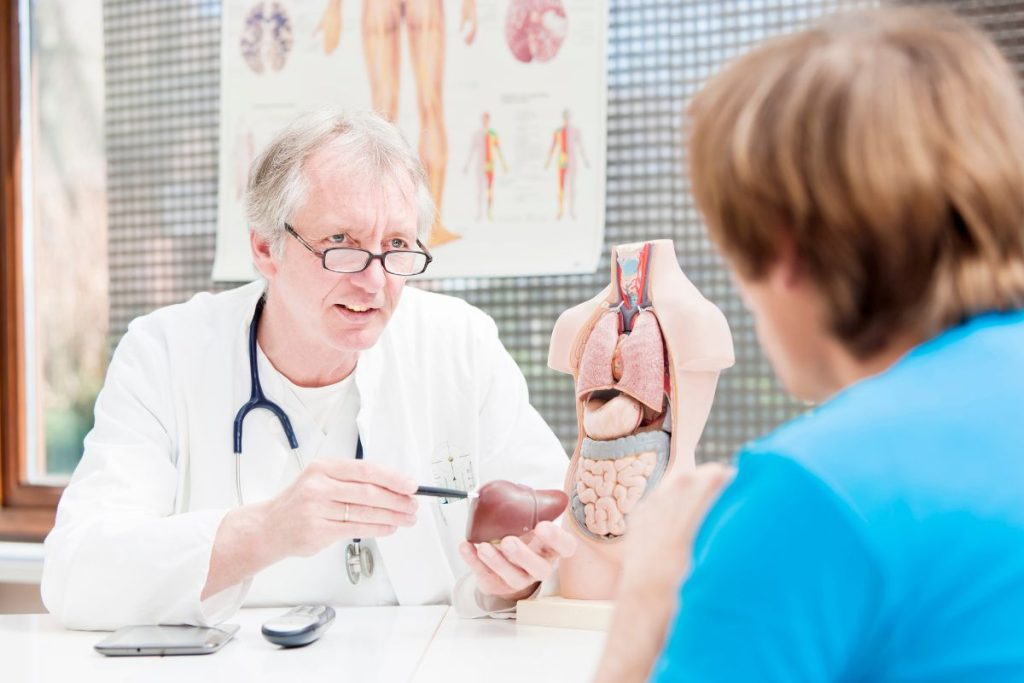8 min. reading
More than a quarter of the world’s population has a fatty liver, most commonly in the form of non-alcoholic fatty liver disease (NAFLD).
Although it often occurs without symptoms, early intervention can effectively support the liver and reduce the risk of more serious complications.
A balanced diet, exercise, stress management and sensible nutraceuticals have been shown to contribute to liver regeneration and better metabolic balance.
Fatty liver is one of the most common diseases of modern times. Many people don’t even know they have it, as the condition goes on for a long time without any obvious signs. However, the liver has a remarkable ability to regenerate – up to 75% of its mass can be restored with the right support.
Natural approaches can make an important contribution to liver health and overall well-being.
Table of contents
How to recognise a blocked liver?

It is a so-called “silent disease”, as the early stages usually do not cause symptoms. If left untreated, it can progress to inflammation, fibrosis or even cirrhosis.
Possible signs include:
- chronic fatigue,
- feeling heavy or full in the upper abdomen,
- discomfort in the right lower back,
- digestive problems,
- weight fluctuations,
- poor concentration,
- elevated liver blood levels.
As the signs are often non-specific, early intervention is essential to prevent disease progression and maintain healthy liver function. Below, we take a look at seven natural strategies that can help regenerate and protect the liver.
7 natural strategies for liver regeneration
The liver has a remarkable ability to regenerate, but it needs the right support to do so. The good news is that we can do a lot ourselves – through diet, lifestyle and targeted support. Below you will find seven proven strategies that you can gradually incorporate into your daily routine
1. Low glycaemic index anti-inflammatory diet
One of the most important strategies for liver health is a diet that reduces inflammation and regulates blood sugar. This prevents insulin resistance, one of the main factors in the development of fatty liver.
- Avoid: white bread, pastries, sugary drinks, processed foods and confectionery
- Choose: green leafy vegetables, good quality protein (fish, eggs, legumes) and healthy fats (olive oil, avocados, nuts)
2. Grenades for bile activation
Grapefruit is one of the oldest natural liver supports, as it stimulates bile secretion, which relieves the liver and improves fat digestion.
- Spotted knapweed
- Artichoke
- Dandelion
- Turmeric
- Gentian
- Ash
3. Nutraceuticals for liver regeneration
To detoxify effectively, the liver needs specific nutrients to support the three phases of the process. Glutathione plays a key role, which can be stimulated by precursors and antioxidants.
- N-acetylcysteine (NAC), glycine, methionine
- Vitamin C, selenium, B vitamins
- Choline, zinc, vitamin E, alpha-lipoic acid, curcumin
To support all three phases of detoxification, check out CellRenew – the expert liver formula.
[Check CellRenew]
4. Time-limited storage
Fasting for 14-16 hours allows the liver to focus on detoxification and repair. It activates autophagy, improves insulin sensitivity and reduces fat accumulation.
- Suitable windows: 10:00-18:00 or 12:00-20:00
- Drink water, unsweetened tea or coffee while fasting
5. Regular physical activity
Exercise reduces inflammation, improves blood flow through the liver and directly reduces the accumulation of liver fat.
- 150-180 minutes of moderate exercise per week
- Strength training 2 times a week
- Fast walking, swimming or cycling
6. Quality sleep
The liver is most active at night, between 1 and 3 am, when key regeneration processes take place. Quality sleep is therefore essential for their recovery.
- Go to bed before midnight
- Keep the bedroom dark and quiet
- Avoid blue light 2 hours before bedtime
- Ideal temperature: 18-20 °C
7. Stress management
Prolonged stress increases cortisol, which worsens insulin resistance and puts extra strain on the liver. Relaxation techniques help maintain hormonal and metabolic balance.
- Breathing exercises, yoga or meditation
- Walking in nature
- Regular contact with friends and family
Small but consistent steps can have the biggest impact. Every change counts – you can start today with a single habit and gradually add new ones.
As a fatty liver is linked to metabolic blockages and weight loss problems, read also:
Why can’t you lose weight despite dieting? The role of detoxification in weight loss

The role of C8 MCT oil in liver health
Scientific support for the use of MCT oil
A study published in Experimental Physiology (2024) showed that MCT oil can significantly reduce liver fat and improve metabolic parameters in mice with fatty liver as early as 6 weeks. This suggests that MCT fats have specific metabolic benefits for the liver.
Key findings:
– Reduced liver fat – effect comparable to low-fat diet
– Improved metabolism – lower liver enzymes (ALT, AST), improved glucose tolerance and insulin sensitivity
– Reduced toxic lipids – only MCT oil reduced hepatic ceramides associated with insulin resistance and inflammation
– Anti-inflammatory effect – lower expression of inflammatory genes in the liver
Source. (2024). Experimental Physiology, 109, 350-364.
Why is the C8 a superior choice?
A fatty liver is often caused by mitochondrial dysfunction – when cells are unable to metabolise fats efficiently. C8 MCT oil directly supports the mitochondria in the liver, where it is quickly converted into energy, thereby reducing fat storage.
Benefits of C8 (caprylic acid):
– Absorbed directly into the portal vein without the help of bile salts
– Reaches the liver and its mitochondrial network quickly
– Oxidised to energy without the need for carnitine transport
Effects of C8:
– Reduces fat deposition in the liver
– Improves mitochondrial energy efficiency
– Reduces toxic ceramides and diacylglycerols
– Acts independently of ketosis
[Check C8 MCT oil]
To learn more about how mitochondria affect energy, ageing and metabolism, read this article:
Mitochondria: How to optimise your cell’s power plants for more energy and health
How does liver detoxification work?
The liver is the main organ of detoxification, processing huge amounts of substances from food, the environment and metabolism every day. To keep the body in balance, these processes must be carried out quickly and efficiently. If detoxification is not working optimally, toxins build up, which puts a strain on the liver cells and affects the health of the whole organism.
The process takes place in three successive stages:
Phase I – Activation
Toxins are converted into intermediates, which are often even more reactive than the parent compounds.
Phase II – Conjugation
In this phase, reactive products are “neutralised” by molecules such as glutathione, sulphates or methyl groups to make them water-soluble and less harmful.
Phase III – excretion
Conjugated substances are excreted via the bile into the intestine or via the kidneys into the urine.
Specific nutrients and enzymes are essential for the smooth functioning of all phases. If any of the phases stall, toxins start to build up in the body, putting a strain on metabolism and regeneration.
For a comprehensive detoxification plan with diet, exercise and liver support, also read the blog Natural Detox: How to support the body’s cleansing processes in 21 days
CellRenew - professional liver support
Although diet, exercise, fasting and stress management play an important role in liver health, sometimes these measures alone are not enough. In the face of increased metabolic stress, chronic fatigue or prolonged exposure to environmental stressors, it is reasonable to consider targeted nutritional support.
CellRenew is an advanced formula with 27 carefully selected active ingredients, designed to support the body in all stages of detoxification. It contains:
- 16 vitamins and minerals
- 5 amino acids
- 6 plant extracts
- key nutraceuticals with a role in liver metabolism and protection
Key benefits of CellRenew
✓ Contributes to normal liver function (choline, milk thistle, artichoke)
✓ Supports natural detoxification processes (NAC, glycine, taurine, methionine)
✓ Protects cells from oxidative stress (vitamins C and E, zinc, selenium)
✓ Helps reduce fatigue and exhaustion (B vitamins, magnesium)
Exposed ingredients
- Spotted knapweed – standardised to 80% silymarin for reliable effect
- NAC (N-acetylcysteine) – a precursor of glutathione, a key antioxidant for phase II detoxification
- Artichoke – stimulates bile flow and relieves liver stress
- Alpha-lipoic acid – regenerates other antioxidants and supports energy metabolism
- Sulforaphane – a natural compound from cruciferous vegetables that stimulates biotransformation enzymes
- Green tea extract – a rich source of catechins, which protect liver cells from oxidative stress and support fat metabolism
Frequently asked questions
Can a blocked liver be improved and cured?
Yes, the liver has a remarkable capacity to regenerate. With dietary changes, exercise and a healthy lifestyle, it can improve significantly, often within a few months. The speed of recovery depends on the degree of impairment and the individual.
How long does it take for the liver to regenerate in fatty liver disease (NAFLD)?
The first improvements, such as more energy and better digestion, can be seen in just a few weeks. Laboratory values such as liver enzymes often improve within 2-3 months, and full recovery can take up to a year.
Is fruit allowed for fatty liver?
Yes, but in moderation. Fruit juices, dried and tropical fruits are best avoided because of their high fructose content.
Which laboratory values indicate a blocked liver?
They are most often monitored:
- ALT and AST (liver enzymes)
- GGT (bile enzyme)
- Triglycerides and HDL
- Fasting glucose and insulin (metabolic syndrome)
Liver ultrasound is most commonly used to confirm the diagnosis.
Is coffee good for a fatty liver?
Moderate coffee consumption (2-3 cups per day without sugar) is associated with a lower risk of NAFLD progression. Coffee contains polyphenols, which may have a beneficial effect on liver metabolism.
Are dietary supplements useful for fatty liver?
Some formulas can provide nutritional support for the liver, fat metabolism and antioxidant protection. However, they are always complementary to a healthy lifestyle, but are not a substitute for a balanced diet and medical supervision.
When to see a doctor for fatty liver?
If you notice:
- pain in the right upper abdomen,
- yellowish discolouration of the skin or eyes,
- unexplained tiredness,
- rapid weight loss or
- elevated liver enzymes in the blood.
Conclusion
A fatty liver is a warning that the body needs more balance and support. The good news is that with natural approaches – a balanced diet, regular exercise, stress management and targeted nutraceuticals – their condition can be significantly improved.
Warning: This article is for information only and is not a substitute for professional advice. Dietary supplements are not a substitute for a balanced diet; effects may vary between individuals.
Authorship: This article was prepared by the Vibrant Longevity team in collaboration with Dr Tina Prodnik – Doctor of Natural Medicine, molecular biologist and functional medicine expert.
For holistic liver and metabolic support, you can combine CellRenew and C8 MCT oil.
Read also:
We also recommend these contents to support your body in detoxifying, regulating hormones and reactivating your metabolism:
- Natural Detox: How to support the body’s cleansing processes in 21 days
Learn a practical 3-week plan to activate your internal detoxification pathways and support your metabolism.
- Why can’t you lose weight despite dieting? The role of detoxification in weight loss
Understand how toxins and an overworked liver can block weight loss and how detoxification can support lasting results.
- Mitochondria: How to optimise cell power plants for more energy and health
Discover how to improve energy, resilience and longevity by optimising mitochondria – key to healthy metabolism and liver regeneration.
 Our online store is open until 10 p.m. 9. 2025 under construction. Occasionally, there may be brief disturbances. Thank you for your understanding.
Our online store is open until 10 p.m. 9. 2025 under construction. Occasionally, there may be brief disturbances. Thank you for your understanding. 
